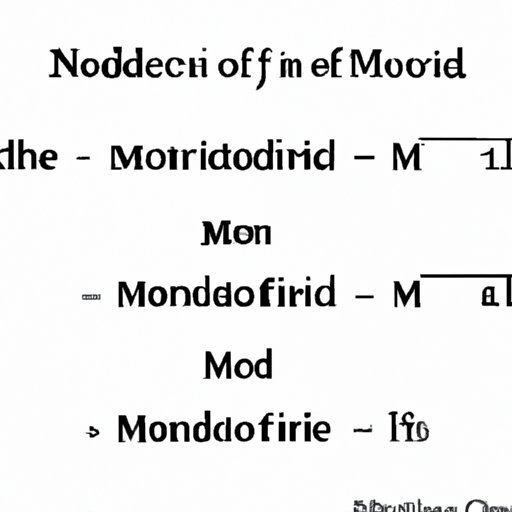
I. Introduction
As we learn more about data analysis and statistics, we often come across the term “mode.” But what exactly is mode, and why is it important to know how to find it? In this article, we will delve into everything about mode, from its definition to its practical application, and provide you with a step-by-step guide on how to find it easily. We will also touch on some other statistical measures, such as mean and median, and how they differ from mode.
II. A Step-by-step Guide on Finding Mode
The mode is the value that appears the most frequently in a dataset. It is a measure of central tendency, just like mean and median. Here’s the step-by-step process for finding mode:
Step 1: Sort the data in ascending or descending order. This will make it easier to spot the most common value(s).
Step 2: Count the frequency of each value. You can do this by hand or use software to make the process quicker.
Step 3: Identify the value(s) with the highest frequency. These are your mode(s).
For example, if we have the following dataset: 7, 5, 5, 9, 7, 4, 5, 3, 8, 5, the mode would be 5 because it appears 4 times, which is more than any other value in the set.
III. Understanding Mode, Mean, and Median
Mode, mean, and median are all measures of central tendency, but they represent different aspects of a dataset. Here’s a breakdown of each measure:
Mean: The average value of the dataset. It is calculated by adding up all the values and dividing by the number of values. Mean is the most commonly used measure of central tendency and is sensitive to outliers.
Median: The middle value when all the values are arranged in ascending or descending order. If there is an even number of values, the median is the average of the two middle values. Median is a better measure of central tendency for skewed datasets.
Mode: The value that occurs most frequently in the dataset. It is the least affected by outliers and is the only central tendency measure that can be used with nominal data.
For example, if we have the following dataset: 5, 5, 7, 8, 9. The mode is 5 because it appears most frequently, the mean is 6.8, and the median is 7.
IV. Interactive infographic to find mode
A visual aid can make the process of finding mode even more straightforward. Here we introduce an Interactive infographic that will help you find the mode step by step.
The Interactive infographic is a simple tool with an easy-to-understand user interface. To use it, enter the values in the box, then press “submit.” The infographic will then calculate the mode and display it for you. This tool can be useful if you’re short on time or want to check your work quickly.
V. When Can We Use the Mode?
Mode is often used in situations where we want to identify the most common value in a dataset. Here are a few real-life examples where the mode can be used:
Example 1: Suppose you run an e-commerce site, and you want to figure out which products are the most popular. You can use the mode to identify the items that are most frequently purchased by customers. This information can help you make informed decisions about your inventory, marketing campaigns, and pricing strategy.
Example 2: You’re analyzing the scores of a group of students. You want to know which score occurs most frequently so that you can determine where the majority of students performed. You can use the mode to identify the most common score.
The mode is especially useful in these types of situations because it provides us with a quick way to identify the most common value(s).
VI. What If There Are Multiple Modes?
Sometimes a dataset can have more than one mode. This occurs when two or more values are tied for the highest frequency. In this case, it is essential to report all the modes accurately. There are two types of datasets with more than one mode: symmetrical and asymmetric.
Symmetrical:
This type of dataset has two modes that are evenly spaced on either side of the mean. For example, in the dataset: 3, 3, 4, 5, 5, 6, 6, the mean is 4.86, and the modes are 4 and 6.
Asymmetric: This type of dataset has two modes that are not evenly spaced on either side of the mean. For example, in the dataset: 2, 2, 2, 3, 4, 4, 5, the mean is 3.25, and the modes are 2 and 4. Note that the modes are not evenly spaced on either side of the mean, which is what distinguishes this type of dataset from symmetrical ones.
VII. Conclusion
Throughout this article, we’ve explored what mode is, why it’s important to understand it, and how to find it. We’ve also touched on some other measures of central tendency, such as mean and median, and when to use them. Remember, the mode is the value that appears most frequently in a dataset and is often used in situations where we want to identify the most common value. By following the step-by-step guide we provided, you can find the mode quickly and accurately.
Remember, mode is only one of the measures you can use to analyze and interpret data. Depending on the type of data you have and the question you’re trying to answer, other measures of central tendency may be more appropriate. It’s essential to understand which measure to use and when to use it.





